Diet and obesity
Diet plays an important role in the genesis of obesity. Personal choices, food advertising, social customs and cultural influences, as well as food availability and pricing all play a role in determining what and how much an individual eats.

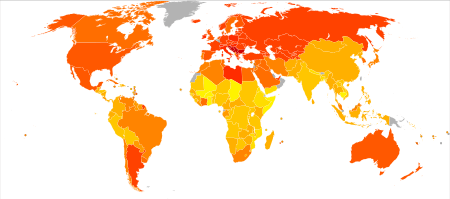
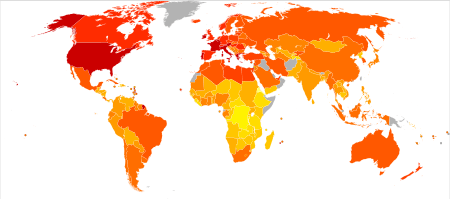
Dietary energy supply
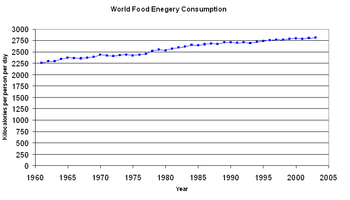
The dietary energy supply is the food available for human consumption, usually expressed in kilocalories per person per day. It gives an overestimate of the total amount of food consumed as it reflects both food consumed and food wasted. The per capita dietary energy supply varies markedly between different regions and countries. It has also changed significantly over time.[2] From the early 1970s to the late 1990s, the average calories available per person per day (the amount of food bought) has increased in all part of the world except Eastern Europe and parts of Africa. The United States had the highest availability with 3654 kilo calories per person in 1996.[3] This increased further in 2002 to 3770.[4] During the late 1990s, Europeans had 3394 kilo calories per person, in the developing areas of Asia there were 2648 kilo calories per person, and in sub-Sahara Africa people had 2176 kilo calories per person.[3][5]
Average calorie consumption
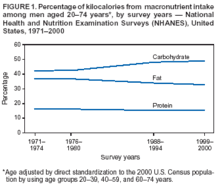
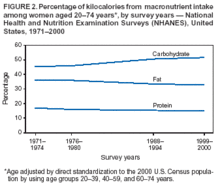

From 1971 – 2000, the average daily number of calories which women consumed in the United States increased by 335 calories per day (1542 calories in 1971 and 1877 calories in 2000). For men, the average increase was 168 calories per day (2450 calories in 1971 and 2618 calories in 2000). Most of these extra calories came from an increase in carbohydrate consumption, though there was also an increase in fat consumption over the same time period.[7] The increase in caloric consumption is attributed primarily to the "consumption of food away from home; increased energy consumption from salty snacks, soft drinks, and pizza; and increased portion sizes".[7] Other sources note that the consumption of soft drinks and other sweetened beverages now accounts for almost 25 percent of daily calories in young adults in America.[8] As these estimates are based on a person's recall, they may underestimate the amount of calories actually consumed.[7]
Fast food
As societies become increasingly reliant on energy-dense fast-food meals, the association between fast food consumption and obesity becomes more concerning.[9] In the United States consumption of fast food meals has tripled and calorie intake from fast food has quadrupled between 1977 and 1995.[10] Consumption of sweetened drinks is also believed to be a major contributor to the rising rates of obesity.[11]
Portion size

The portion size of many prepackage and restaurant foods has increased in both the United States and Denmark since the 1970s.[7] Fast food servings, for example, are 2 to 5 times larger than they were in the 1980s. Evidence has shown that larger portions of energy-dense foods lead to greater energy intake and thus to greater rates of obesity.[12][13]
Meat consumption
A 2010 study published in the American Journal of Clinical Nutrition closely tracked 373,803 people over a period of 8 years across 10 countries. At its conclusion, the study reported that meat consumption is positively associated with weight gain in men and women.[14] In response, the National Cattlemen's Beef Association countered that increased meat consumption may not be associated with fat gain.[15] However, a subsequent response controlled for just abdominal fat across a sample of 91,214 people found that even when controlling for calories and lifestyle factors, meat consumption is linked with obesity.[16] Further population studies, reviews, and meta-analysis studies have corroborated the claim that greater meat consumption is linked to greater rates of obesity.[17][18]
Sugar consumption
Excessive intake of sugar-sweetened beverages (including fruit juices, soft drinks, fruit drinks, sports drinks, energy and vitamin water drinks, sweetened iced tea, and lemonade) increases the risk of metabolic syndrome – which includes obesity and type 2 diabetes among its pathologies – in adults and children by adding to overall energy intake.[19][20][21][22] Children who excessively consume sugar in foods and beverages have a high risk of becoming overweight.[21][22] Reviews indicate that governmental health policies should be implemented to discourage intake of sugar-sweetened beverages and reduce the 21st century trends of increased prevalence of obesity in children and adults.[19][20][21][22] Other than adding excessive calories, the mechanisms by which high sugar consumption causes obesity are unclear because of limitations in clinical research involving uncontrolled factors, such as overall diet, physical activity, and sedentary lifestyle.[19][20][23]
Social policy and change
New agricultural technologies have led to an overall reduction in the cost of food relative to household income, especially in high-income countries. In his popular book, "The Omnivore's Dilemma," the journalist Michael Pollan linked the subsidies offered to farmers of corn, soy, wheat, and rice through the U.S. farm bill to over-consumption of calories derived from these crops and to rising obesity rates.[24] While increased consumption of foods derived from these commodities is correlated with an increase in BMI (at the population level), no current research supports a causal relationship between farm subsidies and obesity.[25] From a policy perspective, the cost of sugar would actually decrease in the US if the commodity support programs in the farm bill were removed, largely due to the tariffs in the farm bill that restrict the importation of lower-cost sugar available on the global market.[26]
Participation by adults in the United States Department of Agriculture Supplemental Nutrition Assistance Program (i.e. Food Stamps) is positively associated with obesity, waist circumference, elevated fasting glucose, and metabolic syndrome.[27]
Metabolism
Evidence does not support the commonly expressed view that some obese people eat little yet gain weight due to a slow metabolism. On average obese people have a greater energy expenditure than normal weight or thin people and actually have higher BMRs.[28][29] This is because it takes more energy to maintain an increased body mass.[30] Obese people also underreport how much food they consume compared to those of normal weight.[31] Tests of human subjects carried out in a calorimeter support this conclusion.[32]
See also
- List of countries by dietary calorie intake
- Criticism of fast food
References
- "Compendium of food and agriculture indicators - 2006". Food and Agriculture Organization of the United Nations. Retrieved February 18, 2009.
- "Compendium of food and agriculture indicators - 2006". UN Food and Agriculture Organization. Archived from the original on August 2, 2008. Retrieved January 10, 2009.
- "Calories per capita per day" (gif). UN Food and Agriculture Organization. Retrieved January 10, 2009.
- "www.fao.org" (PDF). UN Food and Agriculture Organization. Retrieved January 10, 2009.
- "USDA: frsept99b". USDA. Retrieved January 10, 2009.
- "In the Long Run" (PDF). USDA. Archived from the original (PDF) on February 25, 2009. Retrieved February 17, 2009.
- Wright JD, Kennedy-Stephenson J, Wang CY, McDowell MA, Johnson CL (February 2004). "Trends in intake of energy and macronutrients—United States, 1971–2000". MMWR Morb Mortal Wkly Rep. 53 (4): 80–2. PMID 14762332.
- Caballero B (2007). "The global epidemic of obesity: An overview". Epidemiol Rev. 29: 1–5. doi:10.1093/epirev/mxm012. PMID 17569676.
- Rosenheck R (November 2008). "Fast food consumption and increased caloric intake: a systematic review of a trajectory towards weight gain and obesity risk". Obes Rev. 9 (6): 535–47. doi:10.1111/j.1467-789X.2008.00477.x. PMID 18346099.
- Lin BH, Guthrie J, Frazao E (1999). "Nutrient contribution of food away from home". In Frazão E (ed.). Agriculture Information Bulletin No. 750: America's Eating Habits: Changes and Consequences. Washington, DC: US Department of Agriculture, Economic Research Service. pp. 213–239.
- Olsen NJ, Heitmann BL (January 2009). "Intake of calorically sweetened beverages and obesity". Obes Rev. 10 (1): 68–75. doi:10.1111/j.1467-789X.2008.00523.x. PMID 18764885.
- Ledikwe JH, Ello-Martin JA, Rolls BJ (April 2005). "Portion sizes and the obesity epidemic". J. Nutr. 135 (4): 905–9. doi:10.1093/jn/135.4.905. PMID 15795457.
- Steenhuis IH, Vermeer WM (2009). "Portion size: review and framework for interventions". Int J Behav Nutr Phys Act. 6: 58. doi:10.1186/1479-5868-6-58. PMC 2739837. PMID 19698102.
- Vergnaud, Anne-Claire; Norat, Teresa; Romaguera, Dora; Mouw, Traci; May, Anne M.; Travier, Noemie; Luan, Jian'an; Wareham, Nick; Slimani, Nadia (2010-08-01). "Meat consumption and prospective weight change in participants of the EPIC-PANACEA study". The American Journal of Clinical Nutrition. 92 (2): 398–407. doi:10.3945/ajcn.2009.28713. ISSN 1938-3207. PMID 20592131.
- Astrup, Arne; Clifton, Peter; Layman, Donald K.; Mattes, Richard D.; Westerterp-Plantenga, Margriet S. (2010-11-01). "Meat intake's influence on body fatness cannot be assessed without measurement of body fat". The American Journal of Clinical Nutrition. 92 (5): 1274–1275. doi:10.3945/ajcn.110.000661. ISSN 0002-9165. PMID 20844064.
- Vergnaud, Anne-Claire; Norat, Teresa; Romaguera, Dora; Peeters, Petra HM (2010-11-01). "Reply to A Astrup et al". The American Journal of Clinical Nutrition. 92 (5): 1275–1276. doi:10.3945/ajcn.110.000786. ISSN 0002-9165.
- Lin, Yi; Bolca, Selin; Vandevijvere, Stefanie; De Vriese, Stephanie; Mouratidou, Theodora; De Neve, Melissa; Polet, Anja; Van Oyen, Herman; Van Camp, John (2011-04-01). "Plant and animal protein intake and its association with overweight and obesity among the Belgian population". The British Journal of Nutrition. 105 (7): 1106–1116. doi:10.1017/S0007114510004642. ISSN 1475-2662. PMID 21144092.
- Rouhani, M. H.; Salehi-Abargouei, A.; Surkan, P. J.; Azadbakht, L. (2014-09-01). "Is there a relationship between red or processed meat intake and obesity? A systematic review and meta-analysis of observational studies". Obesity Reviews. 15 (9): 740–748. doi:10.1111/obr.12172. ISSN 1467-789X. PMID 24815945.
- Luger, Maria; Lafontan, Max; Bes-Rastrollo, Maira; Winzer, Eva; Yumuk, Volkan; Farpour-Lambert, Nathalie (2017). "Sugar-sweetened beverages and weight gain in children and adults: A systematic review from 2013 to 2015 and a comparison with previous studies". Obesity Facts. 10 (6): 674–693. doi:10.1159/000484566. ISSN 1662-4025. PMC 5836186. PMID 29237159.
- Hu, FB (1 August 2013). "Resolved: there is sufficient scientific evidence that decreasing sugar-sweetened beverage consumption will reduce the prevalence of obesity and obesity-related diseases". Obesity Reviews. 14 (8): 606–19. doi:10.1111/obr.12040. PMC 5325726. PMID 23763695.
- Malik, Vasanti S.; Pan, An; Willett, Walter C.; Hu, Frank B. (1 October 2013). "Sugar-sweetened beverages and weight gain in children and adults: a systematic review and meta-analysis". American Journal of Clinical Nutrition. 98 (4): 1084–1102. doi:10.3945/ajcn.113.058362. ISSN 0002-9165. PMC 3778861. PMID 23966427.
- Guideline: Sugars intake for adults and children. World Health Organization. 2015. ISBN 978 92 4 154902 8.
- Stanhope, Kimber L. (2016). "Sugar consumption, metabolic disease and obesity: The state of the controversy". Critical Reviews in Clinical Laboratory Sciences. 53 (1): 52–67. doi:10.3109/10408363.2015.1084990. ISSN 1040-8363. PMC 4822166. PMID 26376619.
- Pollan, Michael (22 April 2007). "You Are What You Grow". New York Times. Retrieved 2007-07-30.
- Siegel, Karen R.; McKeever Bullard, Kai; Imperatore, Giuseppina; Kahn, Henry S.; Stein, Aryeh D.; Ali, Mohammed K.; Narayan, K. M. (1 August 2016). "Association of Higher Consumption of Foods Derived From Subsidized Commodities With Adverse Cardiometabolic Risk Among US Adults". JAMA Internal Medicine. 176 (8): 1124–32. doi:10.1001/jamainternmed.2016.2410. PMC 6512298. PMID 27379488.
- Aubrey, Allison (2016-07-18). "Does Subsidizing Crops We're Told To Eat Less Of Fatten Us Up?". NPR.org. Retrieved 6 May 2017.
- CW Leung; WC Willett; EL Ding (Jan 2012). "Low-income Supplemental Nutrition Assistance Program participation is related to adiposity and metabolic risk factors". Am J Clin Nutr. 95 (1): 17–24. doi:10.3945/ajcn.111.012294. PMC 3238460. PMID 22170370.
- Kushner, Robert (2007). Treatment of the Obese Patient (Contemporary Endocrinology). Totowa, NJ: Humana Press. p. 158. ISBN 978-1-59745-400-1. Retrieved April 5, 2009.
- Crowe, Tim. "Monday's medical myth: 'my slow metabolism makes me fat'". Retrieved 15 November 2013.
- Adams JP, Murphy PG (July 2000). "Obesity in anaesthesia and intensive care". Br J Anaesth. 85 (1): 91–108. doi:10.1093/bja/85.1.91. PMID 10927998.
- Peter G. Kopelman; Ian D. Caterson; Michael J. Stock; William H. Dietz (2005). Clinical obesity in adults and children: In Adults and Children. Blackwell Publishing. ISBN 978-1-4051-1672-5.
- "mdPassport". Archived from the original on January 11, 2009. Retrieved December 31, 2008.